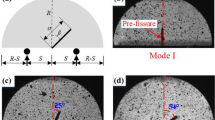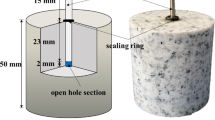Abstract
The fracturing behavior of hard rock under fluid pressure is affected by maximum, minimum, and intermediate principal stress. To investigate the effect of the intermediate principal stress on the hydraulic fracturing behavior, including the fracturing pressure, fracture pattern, fluid pressure evolution, etc., a series hydraulic fracturing experiments of granite under true triaxial compression conditions was conducted. Constant minor and major principal stresses (10 and 30 MPa, respectively) and variational intermediate principal stresses (10, 15, 20, and 25 MPa) were considered. Acoustic emission was used to monitor the hydraulic fracturing process. The effect of different intermediate principal stresses, i.e., various horizontal principal stresses, on the fluid fracturing pressure and failure pattern was studied. With higher intermediate principal stress, the hydraulic pressure fluctuates in the hydraulic fracturing process, whereas at lower intermediate principal stress, the pressure fluctuation phase becomes shorter. The higher intermediate principal stress makes the fracture plane simpler, straighter, and more planar. When the intermediate principal stress equals to the minimum principal stress, the fracture plane tends to be non-planar. In this case, the hydraulic fracture is mainly influenced by heterogeneity of the rocks. With the increase of intermediate principal stress, the formation breakdown pressure of granite decreases, which is different from the effect of minor principal stress. A modified criterion is proposed to reflect the influence of intermediate principal stress on the formation breakdown pressure.















Similar content being viewed by others
References
Al Rbeawi S, Tiab D (2013) Pressure behaviours and flow regimes of a horizontal well with multiple inclined hydraulic fractures. Int J Oil Gas Coal Technol 6(1–2):207–241
Blanton TL (1982) An experimental study of interaction between hydraulically induced and pre-existing fractures. In: SPE unconventional gas recovery symposium. Society of Petroleum Engineers, pp 559–562
Brumley JL, Abass HH (1996) Hydraulic fracturing of deviated wells: interpretation of breakdown and initial fracture opening pressure. In: Spe Eastern regional meeting. Society of Petroleum Engineers, pp 269–293
Casas LA, Miskimins JL, Black AD, Green SJ (2006) Laboratory hydraulic fracturing test on a rock with artificial discontinuities. In: Spe annual technical conference and exhibition. Society of Petroleum Engineers, pp 241–249
Crosby DG, Rahman MM, Rahman MK, Rahman SS (2002) Single and multiple transverse fracture initiation from horizontal wells. J Pet Sci Eng 35(3):191–204
Damani A, Sharma A, Sondergeld CH, Rai CS (2012) Mapping of hydraulic fractures under triaxial stress conditions in laboratory experiments using acoustic emissions. In: Spe annual technical conference and exhibition. Society of Petroleum Engineers, pp 641–653
Daneshy AA (2003) Off-balance growth: a new concept in hydraulic fracturing. J Pet Technol 55(4):78–85
Deng S, Zheng Y, Yue C (2017) Strength model and mesoscopic mechanism of intermediate principal stress effect on rock strength. Sci Sin Technol 47(3):306–315
Deng JQ, Lin C, Yang Q, Liu YR, Tao ZF, Duan HF (2016) Investigation of directional hydraulic fracturing based on true tri-axial experiment and finite element modeling. Comput Geotech 75:28–47
El Rabaa W (1989) Experimental study of hydraulic fracture geometry initiated from horizontal wells. In: Spe annual technical conference and exhibition. Society of Petroleum Engineers, pp 189–204
Erdogan F, Sih GC (1963) Closure to “Discussion of ‘On the Crack Extension in Plates Under Plane Loading and Transverse Shear’” (1963, ASME J. Basic Eng., 85, pp. 525–527). J Basic Eng 85(4):527
Fairhurst C (1964) Measurement of in-situ rock stresses. With particular reference to hydraulic fracturing. Rock Mech Eng Geol 2:129–147
Fallahzadeh S, Hossain M, James Cornwell A, Rasouli V (2017) Near wellbore hydraulic fracture propagation from perforations in tight rocks: the roles of fracturing fluid viscosity and injection rate. Energies 10(3):359
Feng X-T, Zhang X, Kong R, Wang G (2016) A novel mogi type true triaxial testing apparatus and its use to obtain complete stress–strain curves of hard rocks. Rock Mech Rock Eng 49(5):1649–1662
Gonçalves da Silva B, Einstein H (2018) Physical processes involved in the laboratory hydraulic fracturing of granite: visual observations and interpretation. Eng Fract Mech 191:125–142
Griffith AA (1921) The phenomena of rupture and flow in solids. Philos Trans R Soc Lond 221(2):163–198
Haimson B, Chang C (2000) A new true triaxial cell for testing mechanical properties of rock, and its use to determine rock strength and deformability of Westerly granite. Int J Rock Mech Min Sci 37(1–2):285–296
Haimson B, Fairhurst C (1969) In-situ stress determination at great depth by means of hydraulic fracturing. In: The 11th US symposium on rock mechanics (USRMS). American Rock Mechanics Association, pp 559–584
Hampton J, Gutierrez M, Matzar L, Hu D, Frash L (2018) Acoustic emission characterization of microcracking in laboratory-scale hydraulic fracturing tests. J Rock Mech Geotech Eng 10(5):805–817
He H, Dou L, Fan J, Du T, Sun X (2012) Deep-hole directional fracturing of thick hard roof for rockburst prevention. Tunn Undergr Space Technol 32:34–43
Hossain MM, Rahman MK, Rahman SS (2000) Hydraulic fracture initiation and propagation: roles of wellbore trajectory, perforation and stress regimes. J Pet Sci Eng 27(3–4):129–149
Hussain M, Pu S, Underwood J (1973) Strain energy release rate for a crack under combined mode I and mode II. In: Fracture analysis ASTM STP. American Society for Testing and Materials, pp 2–28
Irwin GR (1962) Crack extension force for part-through crack in a plate. J Appl Mech 29(4):651–654
Ito T, Evans K, Kawai K, Hayashi K (1999) Hydraulic fracture reopening pressure and the estimation of maximum horizontal stress. Int J Rock Mech Min Sci 36(6):811–826
Ji W-W, Pan P-Z, Lin Q, Feng X-T, Du M-P (2016) Do disk-type specimens generate a mode II fracture without confinement? Int J Rock Mech Min Sci 87:48–54
Jiang Q, Su G, Feng X, Cui J, Pan P, Jiang J (2015) Observation of rock fragment ejection in post-failure response. Int J Rock Mech Min Sci 74:30–37
Jin X, Shah S (2013) Fracture propagation direction and its application in hydraulic fracturing. In: Spe technical conference and exhibition. Society of Petroleum Engineers, pp 517–536
Kang H, Feng Y (2013) Role of borehole transverse notching on hydraulic fracturing in hard rock. In: The 13th ISRM international congress of rock mechanics, international society for rock mechanics and rock engineering. International Society for Rock Mechanics and Rock Engineering, pp 823–828
King GE (2010) Thirty years of gas shale fracturing: What have we learned? J Pet Technol 62(11):88–90
Lei X, Zhang S, Xu G, Zou Y (2015) Impact of perforation on hydraulic fracture initiation and extension in tight natural gas reservoirs. Energy Technol 3(6):618–624
Li Q, Lin B, Zhai C, Ni G, Peng S, Sun C, Cheng Y (2013) Variable frequency of pulse hydraulic fracturing for improving permeability in coal seam. Int J Min Sci Technol 23(6):847–853
Li Q, Lin B, Zhai C (2014) The effect of pulse frequency on the fracture extension during hydraulic fracturing. J Nat Gas Sci Eng 21:296–303
Li L, Xia Y, Huang B, Zhang L, Li M, Li A (2016) The behaviour of fracture growth in sedimentary rocks: a numerical study based on hydraulic fracturing processes. Energies 9(3):169
Lockner D, Byerlee JD (1977) Hydrofracture in Weber Sandstone at high confining pressure and differential stress. J Geophys Res Atmos 82(14):2018–2026
Lu Y-Q, Zhao J-L, Qian J-D, Wang Y-X, Liu J-Y (1998) Some results of modeling DD seismogenic pattern by the fracture model experiment of large-scale rock samples (I). Acta Seismol Sin 11(2):229–236
Majewska Z, Majewski S, Ziętek J (2013) Swelling and acoustic emission behaviour of unconfined and confined coal during sorption of CO2. Int J Coal Geol 116:17–25
Mao R, Feng Z, Liu Z, Zhao Y (2017) Laboratory hydraulic fracturing test on large-scale pre-cracked granite specimens. J Nat Gas Sci Eng 44:278–286
Miao S, Pan P-Z, Wu Z, Li S, Zhao S (2018) Fracture analysis of sandstone with a single filled flaw under uniaxial compression. Eng Fract Mech 204:319–343
Molenda M, Stöckhert F, Brenne S, Alber M (2015) Acoustic emission monitoring of laboratory scale hydraulic fracturing experiments. In: The 49th US rock mechanics/geomechanics symposium. American Rock Mechanics Association, pp 141–164
Pan PZ, Feng XT, Hudson JA (2012) The influence of the intermediate principal stress on rock failure behaviour: a numerical study. Eng Geol 124:109–118
Pan P-Z, Rutqvist J, Feng X-T, Yan F (2013) Modeling of caprock discontinuous fracturing during CO2 injection into a deep brine aquifer. Int J Greenh Gas Control 19:559–575
Pan P-Z, Rutqvist J, Feng X-T, Yan F (2014) TOUGH–RDCA modeling of multiple fracture interactions in caprock during CO2 injection into a deep brine aquifer. Comput Geosci 65:24–36
Ramos MJ, Espinoza DN, Torres-Verdín C, Shovkun I, Grover T (2016) Laboratory characterization and detection of fractures through combined ultrasonic and triaxial-stress testing. In: The 50th US rock mechanics/geomechanics symposium. American Rock Mechanics Association, pp 16–105
Sih GC (1973) Some basic problems in fracture mechanics and new concepts. Eng Fract Mech 5(2):365–377
Sih GC (1974) Strain-energy-density factor applied to mixed mode crack problems. Int J Fract 10(3):305–321
Sih G (1991) Mechanics of fracture initiation and propagation. Springer, Dordrecht
Song I, Suh M, Won KS, Haimson B (2001) A laboratory study of hydraulic fracturing breakdown pressure in tablerock sandstone. Geosci J 5(3):263–271
Tan P, Jin Y, Hou B, Zheng X, Guo X, Gao J (2017) Experiments and analysis on hydraulic sand fracturing by an improved true tri-axial cell. J Pet Sci Eng 158:766–774
Yan F, Feng XT, Lv JH, Pan PZ, Li SJ (2018a) Continuous-discontinuous cellular automaton method for cohesive crack growth in rock. Eng Fract Mech 188:361–380
Yan F, Pan P-Z, Feng X-T, Li S-J (2018b) The continuous-discontinuous cellular automaton method for elastodynamic crack problems. Eng Fract Mech 204:482–496
Yan F, Pan P-Z, Feng X-T, Li S-J, Jiang Q (2019) A novel fast overrelaxation updating method for continuous-discontinuous cellular automaton. Appl Math Model 66:156–174
Yuyama S, Li ZW, Ito Y, Arazoe M (1999) Quantitative analysis of fracture process in RC column foundation by moment tensor analysis of acoustic emission. Constr Build Mater 13(1–2):87–97
Zeng F, Guo J, Ma S, Chen Z (2018) 3D observations of the hydraulic fracturing process for a model non-cemented horizontal well under true triaxial conditions using an X-ray CT imaging technique. J Nat Gas Sci Eng 52:128–140
Zhao Z, Li X, He J, Mao T, Li G, Zheng B (2018) Investigation of fracture propagation characteristics caused by hydraulic fracturing in naturally fractured continental shale. J Nat Gas Sci Eng 53:276–283
Zheng H, Feng X-T, Pan P-Z (2015) Experimental investigation of sandstone properties under CO2–NaCl solution-rock interactions. Int J Greenh Gas Control 37:451–470
Zhou J, Chen M, Jin Y, Zhang G (2007) Experimental study on propagation mechanism of hydraulic fracture in naturally fractured reservoir. Acta Pet Sin 5(28):109–113
Zhou J, Chen M, Jin Y, Zhang G-Q (2008) Analysis of fracture propagation behavior and fracture geometry using a tri-axial fracturing system in naturally fractured reservoirs. Int J Rock Mech Min Sci 45(7):1143–1152
Zhou C, Wan Z, Zhang Y, Gu B (2018) Experimental study on hydraulic fracturing of granite under thermal shock. Geothermics 71:146–155
Zhu H, Deng J, Jin X, Hu L, Luo B (2015) Hydraulic fracture initiation and propagation from wellbore with oriented perforation. Rock Mech Rock Eng 48(2):585–601
Acknowledgements
This work was supported by the State Key Research Development Program of China (Grant no. 2017YFC0804203), National Nature Science Foundation of China (Grant no. 51621006), Key Research Program of Frontier Sciences, Chinese Academy of Sciences (Grant no. QYZDB-SSW-DQC029), and international cooperation project of Chinese Academy of Sciences (no. 115242KYSB20160024).
Author information
Authors and Affiliations
Corresponding author
Additional information
Publisher's Note
Springer Nature remains neutral with regard to jurisdictional claims in published maps and institutional affiliations.
Rights and permissions
About this article
Cite this article
Pan, PZ., Wu, ZH., Yan, F. et al. Effect of the intermediate principal stress on hydraulic fracturing in granite: an experimental study. Environ Earth Sci 79, 10 (2020). https://doi.org/10.1007/s12665-019-8760-8
Received:
Accepted:
Published:
DOI: https://doi.org/10.1007/s12665-019-8760-8




